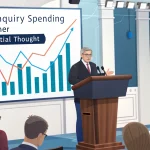Economic indicators pointing to a weakening U.S. economy, coupled with increasing backing for rate cuts within the Federal Reserve, are influencing the decisions of fixed-income investors across markets.
Recent economic data has shown concerning trends that suggest the American economy may be losing momentum. These signs have caught the attention of market participants who invest in bonds and other fixed-income securities, prompting shifts in investment strategies as expectations for future interest rate movements evolve.
The Federal Reserve, which has maintained higher interest rates to combat inflation, now appears to have members increasingly open to the possibility of rate reductions. This shift in sentiment among Fed officials comes as economic growth metrics show signs of cooling.
Economic Warning Signs Emerge
Several key economic indicators have recently fallen short of expectations. Manufacturing activity has slowed, consumer spending has moderated, and the labor market has shown signs of cooling with job creation numbers below forecasts in recent reports.
Housing market data has also reflected the impact of higher interest rates, with home sales declining and construction activity slowing. These factors collectively paint a picture of an economy that may be struggling to maintain its previous growth trajectory.
A fixed-income portfolio manager at a major investment firm noted, “We’re seeing clear signals that the economy is not as robust as it was six months ago. This changes our outlook for interest rates and influences how we position client portfolios.”
Fed Officials Signal Potential Policy Shift
Minutes from recent Federal Reserve meetings and public statements by Fed officials suggest a growing consensus that the central bank may need to consider easing monetary policy. This marks a significant change from the hawkish stance that dominated Fed communications throughout much of the past year.
Several Federal Reserve governors have publicly acknowledged concerns about economic growth, while still noting that inflation remains a consideration. The balancing act between fighting inflation and supporting economic growth appears to be tilting toward the latter.
“We must be attentive to signs that the economy may be slowing more quickly than anticipated and be prepared to adjust policy accordingly,” stated one Federal Reserve official in a recent speech.
Market Response and Investor Positioning
Fixed-income investors are responding to these developments by adjusting their portfolios. Bond prices have risen as yields have fallen in anticipation of potential rate cuts. The yield curve, which had been inverted, is showing signs of normalization as investors price in expectations for easier monetary policy.
Investors are increasingly allocating capital to:
- Longer-duration Treasury bonds, which typically benefit most from rate cuts
- Investment-grade corporate bonds, as the risk of widespread defaults remains low
- Municipal bonds, which offer tax advantages alongside potential price appreciation
Meanwhile, short-term instruments like Treasury bills and money market funds, which had attracted significant inflows during the rate hiking cycle, are seeing some outflows as investors extend duration in their portfolios.
Financial advisors are suggesting clients reassess their fixed-income allocations in light of the changing economic landscape. “The risk-reward calculation has shifted,” explained a senior bond strategist. “With the Fed potentially pivoting toward cuts, investors need to position accordingly.”
Global investors are also closely monitoring U.S. economic data and Fed communications, as U.S. interest rate policy has significant implications for international capital flows and currency markets.
As economic data continues to roll in and Fed officials provide further guidance, fixed-income markets will likely remain sensitive to any signals about the timing and magnitude of potential policy rate adjustments. For now, the growing belief that the Fed will need to cut rates to support a slowing economy is driving investment decisions across the fixed-income spectrum.







